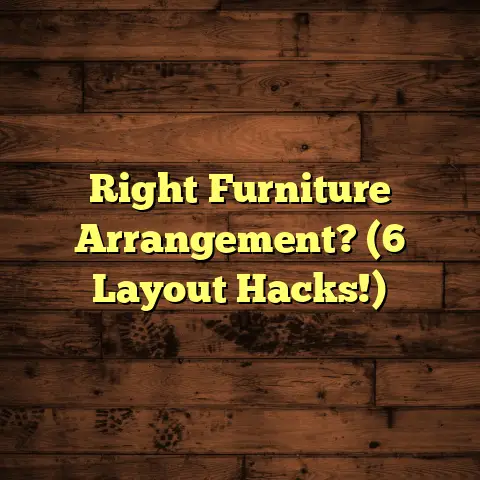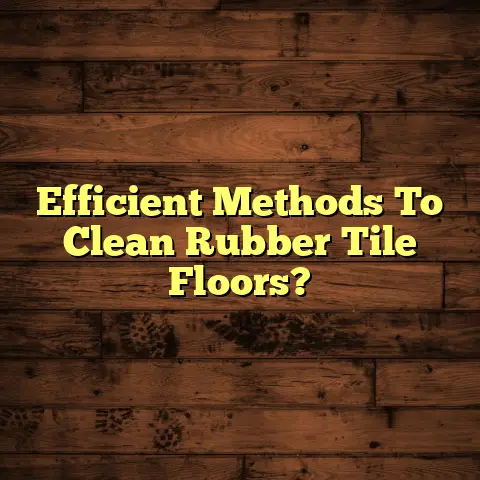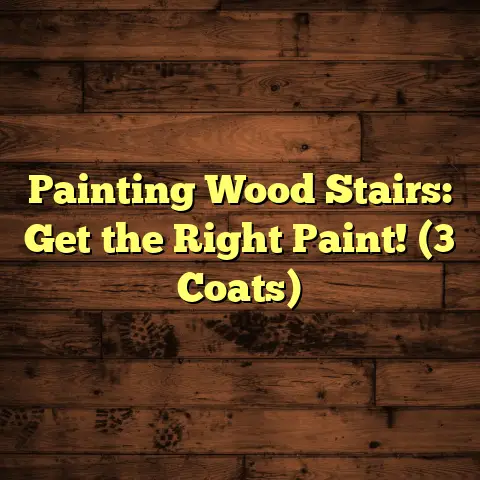Bleaching Dark Wood Floors? (3 Pro Methods!)
“Bleaching dark wood floors is not just about altering the color; it’s about enhancing the natural beauty and character of the wood itself.” – Bob Vila, Renowned Home Improvement Expert.
I’m thrilled you’re diving into the world of wood floor bleaching. As a flooring contractor for over 20 years, I’ve seen trends come and go, but lightening up dark wood floors is seriously having a moment.More and more homeowners want to brighten their spaces, modernize their homes, or simply give their floors a fresh, new look. That’s where bleaching comes in!
In this article, I’m going to walk you through three professional methods for bleaching dark wood floors. We’ll cover everything from the prep work to the post-bleaching care, so you’ll have all the info you need to decide if it’s the right project for you.
Section 1: Understanding Wood Bleaching
1.1 What is Wood Bleaching?
Wood bleaching is basically using chemicals to lighten the color of wood. The goal? To remove or reduce the natural pigments in the wood.
Think of it like hair dye, but for your floors!
There are both chemical and natural methods. Chemical methods use things like hydrogen peroxide or sodium hydroxide. Natural methods? Well, sunlight can actually bleach wood over time, but that’s not exactly a quick fix!
Bleaching can also really bring out the wood grain. By removing some of the color, the natural patterns in the wood become more visible, which can add a ton of character to your floors.
1.2 Why Choose Bleaching?
Why would you even want to bleach your dark wood floors? Great question! I’ve heard a few common reasons over the years:
- Aesthetic Preferences: Maybe you’re tired of the dark, moody look and want something brighter and more modern.
- Lightening a Space: Dark floors can make a room feel smaller and darker. Bleaching can instantly brighten things up.
- Increasing Home Value: Lighter, more modern floors can definitely boost your home’s appeal and potential value.
Right now, lighter wood tones are super popular. Think Scandinavian design, coastal vibes, and minimalist aesthetics. Bleaching can help you achieve that look without completely replacing your floors.
1.3 The Science Behind Bleaching
Okay, let’s get a little nerdy for a second. Bleach works by breaking down the chromophores in the wood. These are the molecules that give wood its color.
Different types of wood react differently to bleach. For example, oak and maple tend to bleach really well, while some exotic woods might not respond as dramatically.
Here’s a quick table showing how different wood types typically react to bleaching:
| Wood Type | Bleaching Result | Notes |
|---|---|---|
| Oak | Lightens significantly, enhances grain | Very popular choice for bleaching |
| Maple | Lightens well, can become almost white | Be careful not to over-bleach |
| Pine | Can become patchy, requires careful application | Always test in an inconspicuous area first |
| Walnut | May not lighten dramatically, but can even out tone | Can also enhance the natural grain patterns |
| Cherry | Can become blotchy, not typically recommended | Professional advice is recommended. |
Source: My own experience and observations over 20 years as a flooring contractor.
Section 2: Pro Method 1: Using Hydrogen Peroxide
2.1 Overview of Hydrogen Peroxide as a Bleach
Hydrogen peroxide is a pretty common household item, but it’s also a fantastic wood bleach. It’s generally safer than some of the harsher chemicals out there, and it’s effective at lightening wood without completely stripping it.
I often recommend hydrogen peroxide for homeowners who are new to bleaching because it’s a bit more forgiving.
It works by oxidizing the wood’s pigments, which means it breaks them down and makes them less visible.
2.2 Preparation Steps
Alright, let’s get down to the nitty-gritty. Here’s what you’ll need for this method:
- Hydrogen Peroxide: 3% to 30% concentration (I usually start with 3% and go stronger if needed).
- Ammonia: Household ammonia (optional, for boosting the effect).
- Paintbrush or Foam Applicator: For applying the bleach.
- Gloves: To protect your hands.
- Safety Goggles: Seriously, don’t skip these.
- Sandpaper: 120-grit and 220-grit.
- Shop Vacuum: For cleaning up dust.
- Clean Rags: For wiping.
- Neutralizing Solution: White vinegar and water (50/50 mix).
Step-by-Step Prep:
- Clear the Room: Remove all furniture and rugs.
- Clean the Floor: Vacuum thoroughly, then clean with a wood floor cleaner.
- Sand the Floor: Start with 120-grit sandpaper to remove any existing finish. Then, smooth it out with 220-grit.
- Vacuum Again: Get rid of all that sanding dust.
- Wipe Down: Use a damp rag to remove any remaining dust. Let it dry completely.
2.3 Application Process
Now for the fun part!
- Test in an Inconspicuous Area: Always, always test before you commit to the whole floor.
- Apply Hydrogen Peroxide: Using your paintbrush or foam applicator, apply an even coat of hydrogen peroxide to the wood.
- Wait and Watch: Let the hydrogen peroxide sit for several hours. You’ll start to see the wood lighten over time.
- Reapply (If Needed): If you’re not seeing enough lightening, you can apply a second coat. For a stronger effect, you can mix in a bit of ammonia (be careful and wear a respirator if you do this!).
- Monitor Closely: Keep an eye on the floor to make sure it’s lightening evenly.
Pro Tip: To avoid streaks, apply the hydrogen peroxide in the direction of the wood grain.
2.4 Post-Bleaching Care
Okay, you’ve bleached your floor. Now what?
- Neutralize the Bleach: Use your white vinegar and water solution to neutralize the hydrogen peroxide. Wipe down the floor thoroughly.
- Let it Dry: Give the floor plenty of time to dry completely.
- Sand Lightly: Use 220-grit sandpaper to smooth out any raised grain.
- Vacuum and Wipe: Clean up the sanding dust.
- Apply a Finish: Seal the wood with a clear coat of polyurethane or another wood floor finish. This will protect the wood and give it a beautiful sheen.
Section 3: Pro Method 2: Using Sodium Hydroxide
3.1 Understanding Sodium Hydroxide for Wood Bleaching
Sodium hydroxide, also known as lye, is a much stronger chemical than hydrogen peroxide. It’s seriously effective for bleaching dark woods, but it’s also more dangerous, so you need to be extra careful.
I usually reserve this method for floors that need a lot of lightening or for woods that are particularly resistant to bleaching.
Sodium hydroxide works by breaking down the lignin in the wood, which is the stuff that gives it its color and structure.
3.2 Preparation Steps
This method requires some serious safety gear!
- Sodium Hydroxide: In flake or crystal form.
- Water: Distilled water is best.
- Buckets: Plastic buckets for mixing.
- Stir Stick: Plastic or wooden.
- Gloves: Heavy-duty, chemical-resistant gloves.
- Safety Goggles: Full face protection is recommended.
- Respirator: With a filter for chemical fumes.
- Acid Neutralizer: Vinegar or citric acid solution.
- Sandpaper: 120-grit and 220-grit.
- Shop Vacuum: For cleaning up dust.
- Clean Rags: For wiping.
Floor Prep:
- Clear the Room: Same as before, get everything out.
- Clean the Floor: Vacuum and clean thoroughly.
- Sand the Floor: Start with 120-grit, then 220-grit.
- Vacuum Again: Remove all sanding dust.
- Wipe Down: Use a damp rag to remove any remaining dust. Let it dry completely.
3.3 Application Process
This is where things get serious. Follow these steps exactly:
- Mix the Solution: In a plastic bucket, slowly add sodium hydroxide to water. The ratio is usually about 2-4 ounces of sodium hydroxide per gallon of water, but always follow the manufacturer’s instructions. Important: Always add the sodium hydroxide to the water, not the other way around. This can cause a dangerous reaction.
- Stir Carefully: Use your stir stick to mix the solution until the sodium hydroxide is completely dissolved.
- Test in an Inconspicuous Area: Seriously, don’t skip this step.
- Apply the Solution: Using a brush or mop, apply the sodium hydroxide solution to the wood.
- Wait and Watch: Let the solution sit for a few hours, monitoring the wood closely. You should see it lighten fairly quickly.
- Rinse with Water: After the desired lightening is achieved, rinse the floor thoroughly with clean water.
Safety First: Make sure you have plenty of ventilation when working with sodium hydroxide. Open windows and use fans to circulate the air.
3.4 Post-Bleaching Care
Neutralizing sodium hydroxide is crucial!
- Neutralize with Acid: Use a vinegar or citric acid solution to neutralize the sodium hydroxide. Apply it to the floor and let it sit for a few minutes, then rinse with clean water.
- Let it Dry: Give the floor plenty of time to dry completely.
- Sand Lightly: Use 220-grit sandpaper to smooth out any raised grain.
- Vacuum and Wipe: Clean up the sanding dust.
- Apply a Finish: Seal the wood with a clear coat of polyurethane or another wood floor finish.
Section 4: Pro Method 3: Using Two-Part Bleach Systems
4.1 Overview of Two-Part Bleach Systems
Two-part bleach systems are a bit more complex than the other methods, but they can be incredibly effective for certain types of wood.
These systems typically involve two separate solutions that you apply in sequence. The first solution usually opens up the wood pores, while the second solution does the actual bleaching.
I like using two-part systems when I need a really consistent and even bleaching result, especially on woods that tend to be tricky to bleach.
4.2 Preparation Steps
Here’s what you’ll need:
- Two-Part Bleach System: Purchase a commercially available two-part wood bleach system.
- Applicators: Brushes, rollers, or sponges, depending on the system’s instructions.
- Gloves: Chemical-resistant gloves.
- Safety Goggles: Full face protection is recommended.
- Respirator: With a filter for chemical fumes.
- Sandpaper: 120-grit and 220-grit.
- Shop Vacuum: For cleaning up dust.
- Clean Rags: For wiping.
Floor Prep:
- Clear the Room: Remove all furniture and rugs.
- Clean the Floor: Vacuum thoroughly, then clean with a wood floor cleaner.
- Sand the Floor: Start with 120-grit sandpaper to remove any existing finish. Then, smooth it out with 220-grit.
- Vacuum Again: Get rid of all that sanding dust.
- Wipe Down: Use a damp rag to remove any remaining dust. Let it dry completely.
4.3 Application Process
Follow the manufacturer’s instructions exactly when using a two-part bleach system. Here’s a general overview:
- Apply Part A: Apply the first solution to the wood, following the instructions for application method and dwell time.
- Apply Part B: After the recommended dwell time for Part A, apply the second solution.
- Wait and Watch: Let the system work its magic. You should see the wood lighten over time.
- Rinse with Water: After the recommended dwell time, rinse the floor thoroughly with clean water.
Pro Tip: Some two-part systems require you to neutralize the bleach with a specific solution. Be sure to follow the instructions carefully.
4.4 Post-Bleaching Care
Finishing is key to protecting your bleached floors.
- Let it Dry: Give the floor plenty of time to dry completely.
- Sand Lightly: Use 220-grit sandpaper to smooth out any raised grain.
- Vacuum and Wipe: Clean up the sanding dust.
- Apply a Finish: Seal the wood with a clear coat of polyurethane or another wood floor finish.
Section 5: Comparing the Methods
Okay, so we’ve covered three different methods for bleaching dark wood floors. Let’s compare them side-by-side:
5.1 Effectiveness
| Method | Effectiveness | Ease of Use | Time Required |
|---|---|---|---|
| Hydrogen Peroxide | Moderate | Easy | Several Days |
| Sodium Hydroxide | Very High | Difficult | 1-2 Days |
| Two-Part Bleach Systems | High, Especially for Difficult Woods | Moderate | 2-3 Days |
5.2 Safety Considerations
| Method | Safety Considerations |
|---|---|
| Hydrogen Peroxide | Wear gloves and safety goggles. Avoid contact with skin and eyes. |
| Sodium Hydroxide | Wear heavy-duty gloves, safety goggles, and a respirator. Work in a well-ventilated area. Neutralize properly. |
| Two-Part Bleach Systems | Wear gloves, safety goggles, and a respirator. Follow the manufacturer’s instructions carefully. Ensure good ventilation |
5.3 Cost Analysis
| Method | Material Costs | Potential Professional Help |
|---|---|---|
| Hydrogen Peroxide | Low (Hydrogen peroxide, sandpaper, finish) | Minimal |
| Sodium Hydroxide | Moderate (Sodium hydroxide, neutralizer, heavy-duty safety gear, finish) | Recommended |
| Two-Part Bleach Systems | Moderate to High (Two-part bleach system, sandpaper, finish) | Optional |
Conclusion
So, there you have it! Three professional methods for bleaching dark wood floors. Each method has its own pros and cons, so it’s important to choose the one that’s right for your specific needs and skill level.
Bleaching dark wood floors can be a transformative project. It can brighten your space, modernize your home, and even increase its value.
Just remember to take your time, follow the instructions carefully, and always prioritize safety.
There’s nothing quite like the satisfaction of stepping back and admiring a beautifully bleached wood floor, knowing that you’ve breathed new life into your home. Good luck, and happy bleaching!





